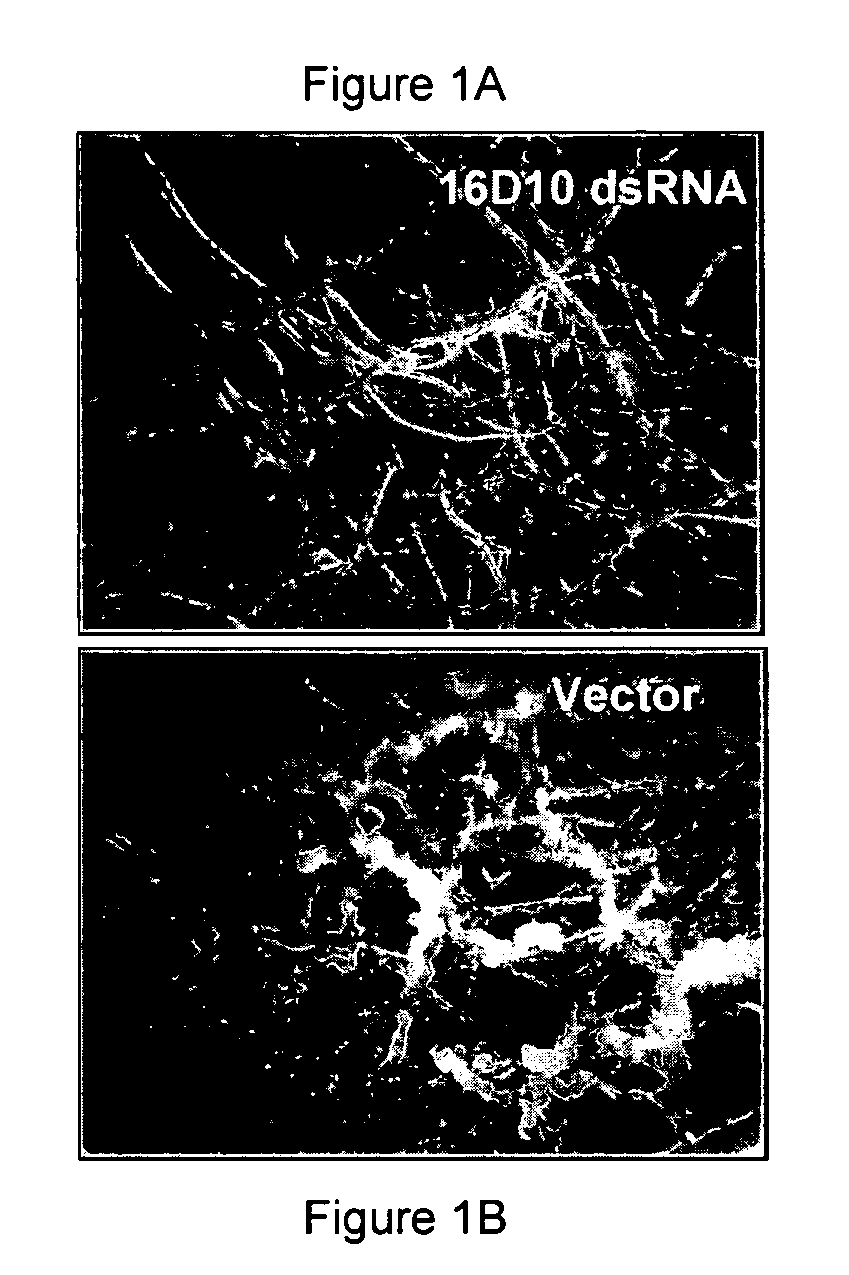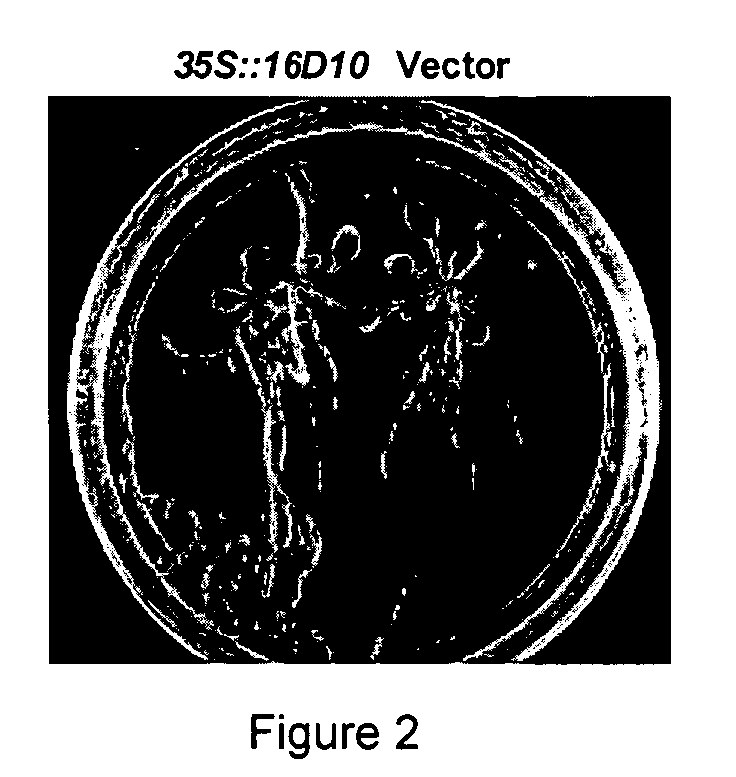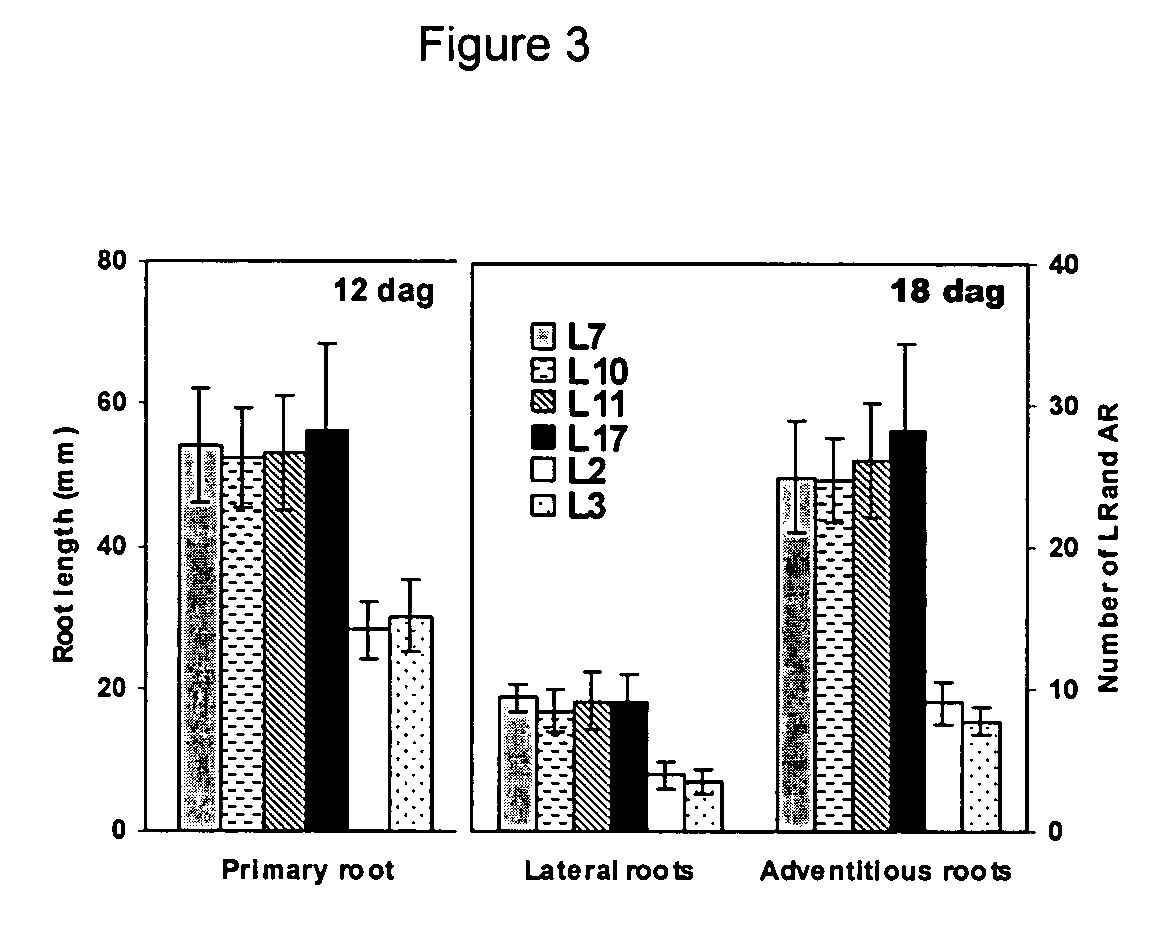Nematode resistant transgenic plants
- Summary
- Abstract
- Description
- Claims
- Application Information
AI Technical Summary
Benefits of technology
Problems solved by technology
Method used
Image
Examples
example 1
Nematodes and Plants
[0185]Meloidogyne species were propagated on roots of greenhouse-grown tomato (Lycopersicon esculentum cv. Marion or Better-Boy). Meloidogyne eggs were collected as described (Hussey and Barker, 1973). Pre-parasitic second-stage juveniles (pre-J2) were collected via hatching eggs on 25-μm-pore sieves in deionized water in plastic bowls. The different parasitic stages of M. incognita were collected by root blending and sieving (Ding et al. 1998). Mixed parasitic stages (MS) of M. incognita for in situ hybridizations were collected 13-15 days after inoculation of eggs as described in De Boer et al. (1998). Similarly, pre-J2 and MS of Heterogera glycines were collected from infected soybean (Glycine max) roots. Caenorhabditis elegans was cultured on OP50 of E. coli (Brenner, 1974). One-month-old host plant leaves were collected from growth-chamber grown Nicotiana tabacum cv. Petite Havana SR1, and Arabidopsis thaliana ecotype Col-0.
example 2
Nucleic Acid Manipulation
[0186] Pre-J2 of packed nematodes were frozen in 1.5-ml microcentrifuge tubes with liquid nitrogen and ground with a smooth-end metal bar. The frozen nematode fragments were mixed with 0.5 ml extraction solution (100 mM NaCl, 100 mM Tris-HCl [pH8.0], 50 mM EDTA, 1% sodium dodecyl sulfate, 4 mg / ml proteinase K and 10 μg / ml RNase) and incubated at 37° C. for 1 hr. DNA was extracted with phenol / chloroform and then precipitated with isopropanol (Sambrook et al., 1989). The DNA was re-suspended in H2O. Tobacco and Arabidopsis genomic DNA was extracted using standard techniques (Dellaporta 1993).
[0187] mRNAs were extracted and purified from ground plant tissues using Dynabeads mRNA DIRECT kit (Dynal, Lake Success, N.Y.), eluted with 10 μl diethylpyrocarbonate (DEPC)-treated water, and converted into first-strand cDNA by reverse transcription (RT)-PCR SMART PCR cDNA Synthesis kit (BD Biosciences, Palo Alto, Calif.), following the manufacturer's instructions. RT-P...
example 3
Isolation of 16D10 cDNA Clone
[0188] Clone 16D10 encoding a secretory signaling peptide was identified during random sequencing of a gland-cell specific cDNA library of M. incognita (Huang et al., 2003) and designated as 16D10. The full-length double-strand cDNA sequences of 16D10 in pGEM-T Easy vector were obtained by using T7 and SP6 primers in sequencing reactions. The longest open reading frame of the 16D10 cDNA (364 bp) encoded a deduced protein of 43 aa including a 30 aa N-terminal hydrophobic signal peptide as predicted by Signal P (Nielsen et al, 1997). While the mature 16D10 peptide of 13 aa (GKKPSGPNPGGNN, Mr 1,223 Da)(SEQ ID NO:52) provided no significant BLASTX similarity, it did contain 8 aa (K---PSGPNP--N) (SEQ ID NO:53) of the conserved C-terminal 13 aa motif (KRLVPSGPNPLHN)(SEQ ID NO:54) of the functional domain of Arabidopsis CLV3-like proteins (Cock and McCormick, 2001) as well as a cAMP / cGMP-dependent protein kinase phosphorylation site [KKpS] as predicted by PROS...
PUM
| Property | Measurement | Unit |
|---|---|---|
| Electrical resistance | aaaaa | aaaaa |
| Acidity | aaaaa | aaaaa |
| Gene expression profile | aaaaa | aaaaa |
Abstract
Description
Claims
Application Information
 Login to View More
Login to View More - Generate Ideas
- Intellectual Property
- Life Sciences
- Materials
- Tech Scout
- Unparalleled Data Quality
- Higher Quality Content
- 60% Fewer Hallucinations
Browse by: Latest US Patents, China's latest patents, Technical Efficacy Thesaurus, Application Domain, Technology Topic, Popular Technical Reports.
© 2025 PatSnap. All rights reserved.Legal|Privacy policy|Modern Slavery Act Transparency Statement|Sitemap|About US| Contact US: help@patsnap.com



